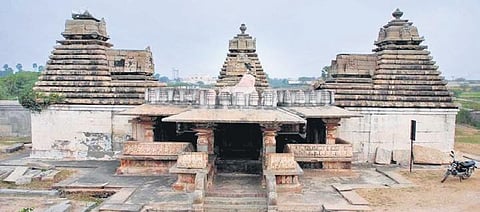

HYDERABAD: After achieving the UNESCO World Heritage tag for the Kakatiya Rudreshwara temple (Ramappa temple), Telangana has proposed two monuments with architectural and astronomical magnificence for coveted recognition this year. Heritage Telangana has listed Niluvurallu in Mudumal village of Narayanpet district and Chaya Someshwaralayam as the sites that deserve due recognition.
The Nilivurallu megalithic burial site, with around 80 menhirs and thousands of stone alignments from nearly 3,500 years ago, has made researchers from across the globe curious as the menhirs, when observed during solstice and equinox, were perfectly aligned with the sun. As another testimony of the astronomic genius that lived there in prehistoric times, a stone boulder revealed cup marks, which shows the ‘Saptarshi Mandal’ or Ursa Major.
Another lesser-known wonder created by the medieval temple architects of the Telangana region is the Chaya Someshwaralayam in Panagal, located on the outskirts of Nalgonda town. This temple, which was in dilapidated condition in 1999, has been renovated and brought back to life with the efforts of historians like Dr D Surya Kumar and other officials of the archaeology and museums department of the erstwhile AP.The mystery surrounding the temple has always been about a shadow appearing like a pillar, which falls on the presiding deity, the Shiva Linga of the ‘Trikutalayam’ daily.
Surya Kumar said the temple was built by Kanduru Chodas, who ruled as feudal lords for Kalyani Chalukyas in the 11th and 12th centuries.There are two pillars in front of each of the Trikutalayas (three temples) within the temple. The Shiva linga is located towards the West, facing the East. Light enters the sanctum sanctorum from a gap between the walls. Beautiful carvings explain mythological stories like Ramayana and Mahabharata on the pillars.
The wider evidence for Kanduru Chodas’ architecture with all its cultural and natural aspects can be established due to the presence of Udayasamudram, a reservoir built by Udayana Choda between 1109 and 1136 AD close to the temple. The reservoir is still the primary source of water for five villages.